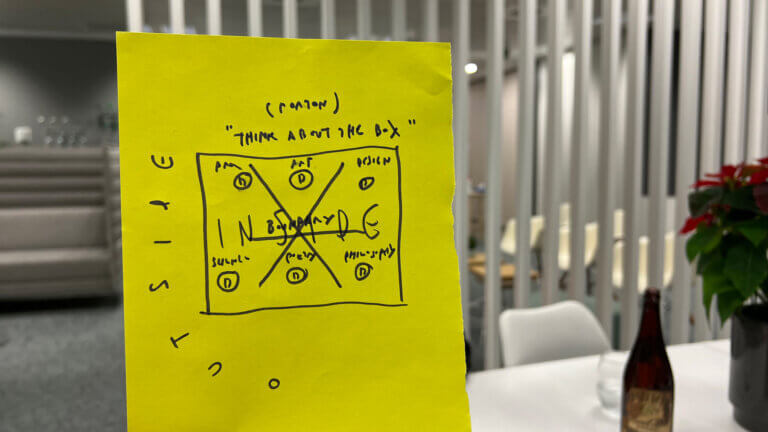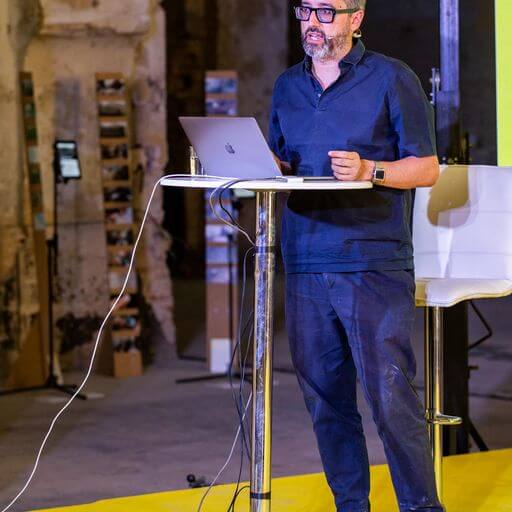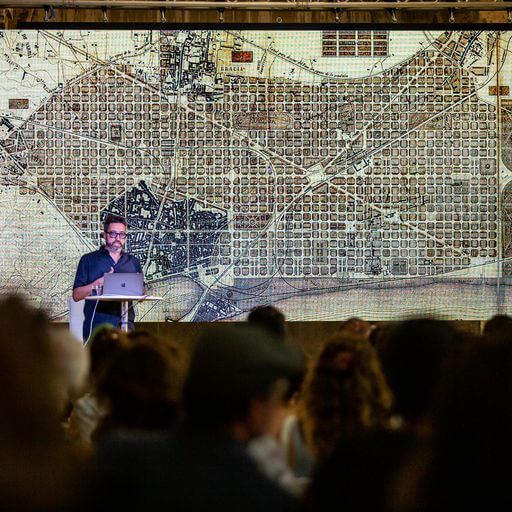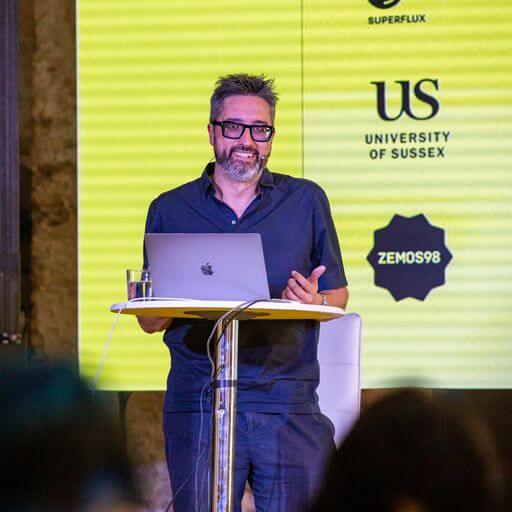José Luis de Vicente
To think outside of the box, we actually need to be aware of how the box was made
In order to try to produce a message, I had to make a drawing to understand what I wanted to say. Sometimes I learned that we write things or we draw schematics because thinking sometimes happens inside of your head and actually having a surface to put your thinking on helps you. When I have been asked about what I’ve learned or what I’d like to convey about my creative practice, I’ve thought about a sentence by a friend of mine, philosopher Timothy Morton, who when once asked why we are usually requested to think outside of the box when we want to solve a problem, he actually suggests the contrary: to think about the box. What is the box made of? Which is what is the space or the constraint or the context in which we think things and produce answers, and look for answers in our creative quest. And for me, it looks something like this, there is an inside and an outside. The outside is the world in which we operate and the inside is the place of production, of knowledge; that place to which we go, and we say, “here is where knowledge resides.” And knowledge has been built by institutions, by communities, by centuries, centuries of traditions and embedded practices, and books, and history in a way. And then inside it, we have built all these things. There are spaces, there are disciplines. So there is architecture here and there is order, there is design, there is science, there is technology, there is poetry, there is philosophy; there are all these spaces that we have been encasing in boundaries, because all these spaces are very clear. “Hey, you are into the jurisdiction of this space and not the jurisdiction and not in the other”.
And for me, to think about the box is really to think about how has this whole thing been built up? Because by knowing how it’s been built, you can recognize that it is historical. It has existed because of some reasons, but it’s also contingent. It doesn’t need to exist the way that it does forever. I feel a certain attachment to the word anti-disciplinary. Not to the conviction of everybody. I have a constant ongoing discussion with my girlfriend who thinks that being anti something is not good, but we can be anti-colonialist or anti-racist and that is perfectly fine. So I am basically not a big fan of these big walls. That helps you to jump over the wall to get from space, from science to art or from poetry to architecture or from philosophy, from design. And sometimes it’s very nice feeling like a hacker or like someone who sneaks into one of these places without ever feeling that it really belongs there. But you know what? The secret is that we all belong here. We all belong in any of these spaces because the boundaries, the inside and the outside are just artifacts that the box was built over or made of in order to design. So to think outside of the box, we actually need to be aware of how the box was made. And if we were to start anew, maybe we would design the box completely differently or we would decide that we don’t need a box.
There is nothing given in the way that we live
It’s always hard to talk about the reasons why you do things because it’s not as if you had a lot of choices. It’s like this comes from the expression of a particular voice that you built, of a vocabulary that you have built that is made up of tiny obsessions and big influences and some impulses. So it’s not easy to unpack that. But I think I must be fascinated by the devices of art and its capacities to show that there is nothing given in the way that we live. The constant experiments of ‘what if?’ are actually to question that we shouldn’t take things for granted, as immutable realities. It’s something incredibly potentially transformative.
The space of the imagination is a part of reality and that allows us to predict other possible realities
It fascinates me that we can build spaces that are potentially truly transformative and use the potential of art, of creativity, to remind everybody of this space of the imagination as something that is a part of reality and that allows us to predict ourselves into other possible realities but transcending the self limitation; the sublime arts impulse in self. Because art is very important and is very serious and is very transcendent […] I think there is a transformational potential in also developing strategies for calling everybody’s attention.
The act of collaboration is very, very beautiful and very unique
I love being collaborative in the sense that even though it’s hard, even though it’s difficult, it’s like friendship: it’s difficult and it’s frustrating, sometimes it is unfair. But the act of collaboration is very, very beautiful and very unique in creative terms. And then there is something that you couldn’t have done by yourself, and then there is somebody else who couldn’t have done this by themselves. And then in the overlap of both of your shadows, something arises. And that is really magical. So I don’t feel completely in control of these dynamics.

About José Luis de Vicente
José Luis is a curator and cultural researcher on the current and future impact of social and technological innovation. He is the curator of Sónar +D and has curated several exhibitions, in and outside of Spain, such as ‘Big Bang Data’ and ‘After the End of the World’ (both at the CCCB), ‘Atmospheric Memory’ (Manchester International Festival), and others.
CreaTures resources
De Vicente, J. L. (2022) On Considering Ourselves at Every Scale [Festival keynote]. CreaTures Festival, Sevilla, Spain.
Mattelmäki, T. (2021). Creative practices for transformational futures [Presentation]. Beyond sustainability-as-usual: co-creating transformative change in sustainable living. Aalto University, New European Bauhaus event.
Light, A. (2020). Creative approaches to climate and system change: Making futures through critical cultural change [Conference panel]. POLLEN Conference 2020.
Light A. (2022). Ecologies of Subversion: Troubling Interaction Design for Climate Care. interactions 29 (1) 34–38. https://doi.org/10.1145/3501301
Thornton, C. Wallis, L. & Furtherfield. (2021). The Hologram: Collective health as really beautiful artwork.ACM Interactions 28(1).



